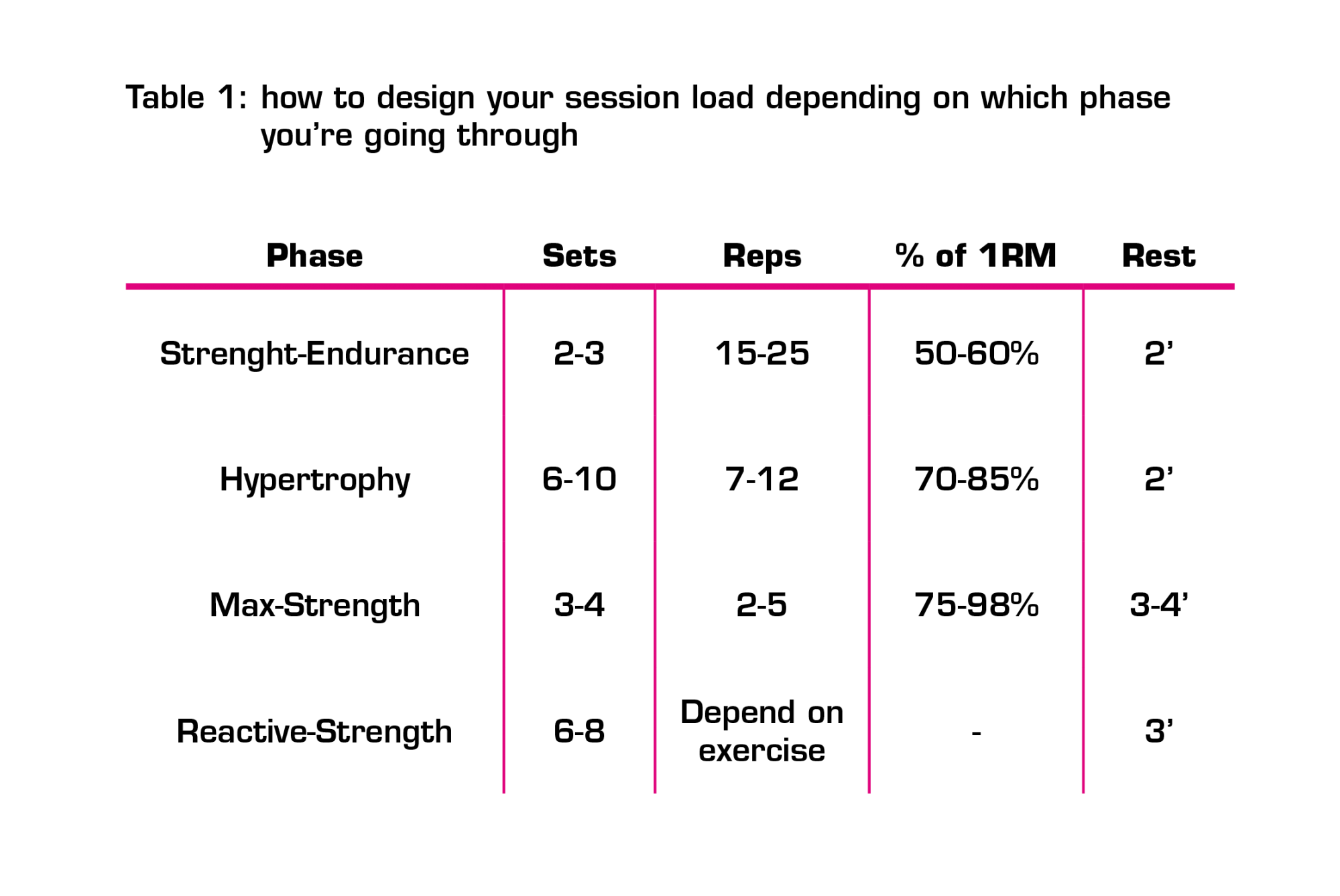How can you include strenght sessions for better results?
 DIFFERENT TYPES OF STRENGHT TRAINING
DIFFERENT TYPES OF STRENGHT TRAINING
Strength-Endurance:
This strength regimen primarily refers to the ability to withstand fatigue during prolonged muscular effort. This training modality is characterized by a high number of repetitions and light loads.
Hypertrophy:
The goal of hypertrophy is to gain muscle mass by increasing cross sectional area. Therefore, recovery is not essential as fatigue is deliberately sought to enhance protein synthesis and the proliferation of muscle cells.
Maximal Strength:
This regimen pertains to the maximum force that a muscle or group of muscles can generate during maximal voluntary contraction. The increase in maximal strength occurs initially through improved intramuscular coordination, involving the significant recruitment of muscle fibers. In this type of training, exercises involve the use of machines (whether multi-joint or single-joint) and substantial loads with few repetitions. Be attentive and ensure caution regarding your posture!
Reactive Strength:
Also known as plyometric strength, this refers to the ability of a muscle or group of muscles to generate a powerful force impulse in a stretch-shortening cycle. This cycle involves the rapid stretching of the muscle (eccentric phase) followed by a quick contraction (concentric phase). In other words, it is the muscles' capacity to decelerate or absorb an initial force before producing an explosive force in the opposite direction (for example: the running cycle). This ability is developed through plyometric exercises such as high box jumps, drop jumps, sprints, etc. To prevent injuries, it is recommended not to train reactive strength without having established a sufficient foundation in the realms of endurance-strength and maximal strength.
EXERCISE ORDER
When designing your strength training session, you will choose your exercises and place them in a logical order. You want to begin with multi-joint exercises (e.g. a backsquat). They are the one recruiting the biggest muscle mass. They typically involve the use of free weight and need a complexe coordination and nervous activation. You will then place mono-articular exercises (e.g. leg extension). These exercises are great to target specific muscular groups and present the advantage of not requiring great technical skills. It is therefore safer for beginners or at the end of a session, when fatigue kicks in.
A TYPICAL STRENGTH TRAINING SESSION FOR SKI-MOUNTAINEERING
If you are in the maximal strength phase, a typical workout might look like a warm-up consisting of cardiovascular activation (treadmill running, cycling, rowing, etc.), a mobility routine, a core training routine, and repeating the exercises included in the following session with no added weight. A typical maximal strength session could look like this:
3 sets of 5-6 reps at 85-95% of 1RM, with a rest period of 3 minutes between sets.
- Back squat, then Leg press
- Deadlift, then Leg curl
- Hipthrust, then Glute press
- Bent over Row, then Cable rows
- Bench press, then Chest press machine
If you are not currently in the maximal strength phase, you can keep these exercises while adjusting the number of repetitions and the rest time, referring to the table 1 above.
To learn more about strength training:
Bompa TO, Buzzichelli C. Periodization Training for Sports. Third Edit. Champaign: Human Kinetics; 2015.
Folland, J. P., & Williams, A. G. (2007). Morphological and neurological contributions to increased strength. Sports medicine, 37, 145-168.
Hickson, R. C., Dvorak, B. A., Gorostiaga, E. M., Kurowski, T. T., & Foster, C. (1988). Potential for strength and endurance training to amplify endurance performance. Journal of applied physiology, 65(5), 2285-2290.
Penzer, F., Cabrol, A., Baudry, S., & Duchateau, J. (2016). Comparison of muscle activity and tissue oxygenation during strength training protocols that differ by their organisation, rest interval between sets, and volume. European journal of applied physiology, 116, 1795-1806.
Ratamess, N. A., Alvar, B. A., Evetoch, T. E., Housh, T. J., Ben Kibler, W., Kraemer, W. J., & Triplett, N. T. (2009). Progression models in resistance training for healthy adults. Medicine and science in sports and exercise, 41(3), 687-708.
